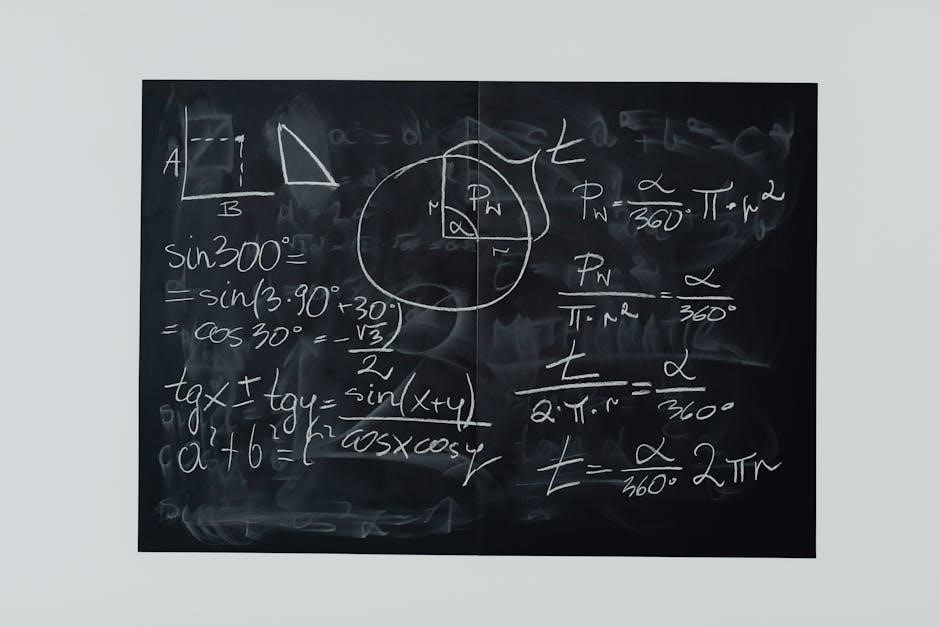The Intermediate Algebra PDF is a comprehensive guide covering essential algebraic concepts, including factoring, functions, and graphing, designed to enhance mathematical understanding and problem-solving skills effectively․
Overview of the Topic
Intermediate Algebra is the second part of a two-part algebra course, building on foundational concepts to deepen understanding and practical application․ It covers essential topics such as functions, linear systems, radical and exponential expressions, and graphing lines․ The Intermediate Algebra PDF serves as a comprehensive resource, offering a clear and structured approach to learning․ Designed for clarity, it includes detailed explanations, examples, and exercises to help students master algebraic skills․ This resource is ideal for students needing a refresher or those progressing to advanced mathematics, providing a solid foundation for future academic and real-world applications․
Key Features of Intermediate Algebra PDFs
Intermediate Algebra PDFs are free, open-source resources designed to enhance learning․ They cover a wide range of topics, including functions, linear systems, and exponential expressions, with detailed explanations and exercises․ Many PDFs are licensed under Creative Commons, allowing easy sharing and redistribution․ They often include supplementary materials like video tutorials and practice problems, accessible through platforms like BCA/iLrn Tutorial․ Structured with clear tables of contents, these PDFs provide a comprehensive and organized approach to mastering intermediate algebra․ Their accessibility and comprehensive coverage make them invaluable tools for students seeking to improve their algebraic skills effectively․
Importance of Intermediate Algebra in Math Education
Intermediate Algebra is a foundational course that bridges basic algebra to advanced mathematics, fostering critical thinking and problem-solving skills․ It equips students with essential tools for STEM fields and everyday problem-solving․ By mastering intermediate algebra, learners build a strong mathematical foundation, enabling them to tackle complex concepts in calculus, statistics, and beyond․ It emphasizes logical reasoning, analytical thinking, and practical applications, making it a cornerstone of math education․ Proficiency in intermediate algebra is often a prerequisite for college-level courses, highlighting its significance in academic and career pathways․
Structure of Intermediate Algebra PDFs
Intermediate Algebra PDFs typically include a clear table of contents, detailed chapter breakdowns, and a logical progression from basic to advanced topics, ensuring organized learning․
Table of Contents and Chapter Breakdown
The Intermediate Algebra PDF typically starts with expressions and exponents, progressing through functions, linear systems, and inequalities․ Chapters often include radical and exponential expressions, graphing lines, and conic sections․ Detailed sections focus on factoring polynomials, with guided practice exercises․ The table of contents is designed to build skills sequentially, ensuring mastery of each topic before advancing․ Additional resources like video tutorials and practice problems are often included, enhancing the learning experience․ This structured approach helps students navigate complex algebraic concepts with ease and confidence․
Progression from Basic to Advanced Topics
The Intermediate Algebra PDF begins with foundational concepts like expressions and exponents, gradually introducing more complex topics such as functions and linear systems․ It transitions smoothly into advanced areas, including radical and exponential expressions, graphing, and conic sections․ Each chapter builds on the previous one, ensuring a logical progression from basic to advanced algebraic skills․ This structured approach helps students master essential concepts before tackling more challenging material, fostering a deep understanding and preparing them for higher-level math courses․

Factoring Polynomials in Intermediate Algebra
Factoring polynomials is a cornerstone of intermediate algebra, emphasizing the use of the Greatest Common Factor (GCF) and advanced techniques to simplify expressions and solve equations effectively․
Using the Greatest Common Factor (GCF)
Using the Greatest Common Factor (GCF) is a fundamental technique in factoring polynomials․ The GCF is the largest expression that divides each term of the polynomial without leaving a remainder․ To apply this method, identify the GCF of all terms, then factor it out, distributing the remaining terms inside parentheses․ This process simplifies expressions, making them easier to work with in further calculations․ Mastering GCF factoring is essential for solving complex algebraic problems and building a strong foundation in intermediate algebra, as emphasized in many educational resources like the Intermediate Algebra PDF by Tyler Wallace․
Advanced Factoring Techniques
Advanced factoring techniques go beyond the GCF, incorporating methods like factoring trinomials, difference of squares, and sum or difference of cubes․ These techniques are crucial for simplifying complex expressions and solving higher-level algebraic equations․ Resources such as Tyler Wallace’s Intermediate Algebra PDF provide detailed guidance on these methods, emphasizing their practical applications in problem-solving․ Mastery of advanced factoring is essential for progressing in algebra and preparing for more complex mathematical concepts, as highlighted in various educational materials and PDF guides available online․

Functions and Linear Systems
Functions and Linear Systems explore the properties of functions, their graphs, and real-world applications․ Linear systems involve solving equations with multiple variables, essential for modeling various scenarios in mathematics and science․
Understanding Functions and Their Properties
Functions are fundamental in algebra, representing relationships between variables․ Properties like domain (input values) and range (output values) define their behavior․ Evaluating functions involves substituting inputs to find outputs, while concepts like one-to-one functions and inverse functions extend their utility․ Composite functions allow combining functions, enabling complex problem-solving․ Understanding these properties is crucial for graphing, solving equations, and modeling real-world scenarios, such as growth rates or financial calculations․ Mastering functions builds a strong foundation for advanced algebra and its practical applications in various fields, emphasizing their importance in mathematical problem-solving and critical thinking skills․
Solving Linear Systems of Equations
Linear systems of equations involve solving for variables in multiple equations․ Methods include substitution, elimination, and graphical approaches․ Substitution requires solving one equation for a variable and substituting it into another․ Elimination involves combining equations to eliminate a variable․ Graphical methods visualize the intersection of lines, representing solutions․ These techniques are essential for modeling real-world problems, such as budgeting or resource allocation․ Accurate solutions require careful algebraic manipulation and attention to detail․ Mastery of these methods enhances problem-solving skills and prepares students for advanced mathematical concepts and practical applications in various disciplines․

Graphing in Intermediate Algebra
Graphing in Intermediate Algebra covers plotting lines, inequalities, and functions․ It introduces conic sections and emphasizes understanding graphical relationships to solve real-world problems visually and analytically․
Graphing Lines and Inequalities
Graphing Lines and Inequalities is a fundamental skill in intermediate algebra, enabling students to visualize relationships between variables․ Lines are plotted using slope-intercept form (y = mx + b), identifying intercepts and slope․ Inequalities extend this by adding shaded regions to represent solution sets․ This section covers various line forms, such as standard and intercept forms, and teaches how to interpret inequality graphs for practical problem-solving․ Understanding these concepts is crucial for analyzing real-world data and systems of equations effectively․ It bridges algebraic expressions with their geometric representations, enhancing problem-solving abilities․
Conic sections are curves obtained by intersecting a plane with a double-napped cone, resulting in shapes like circles, ellipses, parabolas, and hyperbolas․ These shapes are fundamental in algebra and geometry, with applications in engineering, physics, and real-world problems․ The Intermediate Algebra PDF introduces conic sections, focusing on their standard forms, properties, and equations․ Students learn to identify and graph these sections, understanding their symmetries and key features․ This section builds on earlier concepts of graphing lines and inequalities, preparing learners for advanced problem-solving in mathematics and related fields․ Conic sections are essential for modeling various phenomena and solving complex equations․

Applications of Intermediate Algebra
Intermediate Algebra has numerous real-world applications in fields like engineering, economics, and physics․ It aids in solving practical problems, such as budgeting, optimization, and scientific modeling, preparing students for advanced math․
Real-World Problems and Practical Examples
Intermediate Algebra PDFs often include practical examples that demonstrate how algebraic concepts apply to real-world scenarios․ These resources provide exercises on budgeting, mixture problems, and optimization, helping students see the relevance of algebra in everyday life․ For instance, solving equations can help determine the best pricing strategies in business or calculate distances in physics․ Practical examples also cover geometric applications, such as calculating areas for construction projects or understanding population growth patterns․ These real-world problems enhance problem-solving skills and logical thinking, making algebra more engaging and applicable for students․
Preparation for Advanced Math Courses
Intermediate Algebra PDFs serve as a bridge to advanced mathematics by reinforcing foundational concepts․ These resources emphasize critical skills like solving equations, working with functions, and graphing, which are essential for courses like calculus and statistics․ By mastering intermediate algebra, students develop a strong problem-solving framework necessary for higher-level math․ The structured progression of topics ensures readiness for more complex subjects, making these PDFs invaluable for students aiming to excel in STEM fields or further their mathematical education․